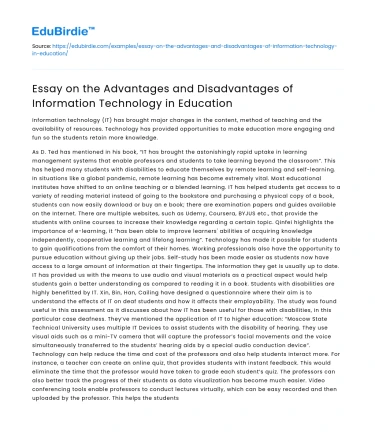Information technology (IT) has brought major changes in the content, method of teaching and the availability of resources. Technology has provided opportunities to make education more engaging and fun so the students retain more knowledge.
As D. Ted has mentioned in his book, “IT has brought the astonishingly rapid uptake in learning management systems that enable professors and students to take learning beyond the classroom”. This has helped many students with disabilities to educate themselves by remote learning and self-learning. In situations like a global pandemic, remote learning has become extremely vital. Most educational institutes have shifted to an online teaching or a blended learning. IT has helped students get access to a variety of reading material instead of going to the bookstore and purchasing a physical copy of a book, students can now easily download or buy an e book; there are examination papers and guides available on the Internet. There are multiple websites, such as Udemy, Coursera, BYJUS etc., that provide the students with online courses to increase their knowledge regarding a certain topic. Qinfei highlights the importance of e-learning, it “has been able to improve learners' abilities of acquiring knowledge independently, cooperative learning and lifelong learning”. Technology has made it possible for students to gain qualifications from the comfort of their homes. Working professionals also have the opportunity to pursue education without giving up their jobs. Self-study has been made easier as students now have access to a large amount of information at their fingertips. The information they get is usually up to date. IT has provided us with the means to use audio and visual materials as a practical aspect would help students gain a better understanding as compared to reading it in a book. Students with disabilities are highly benefitted by IT. Xin, Bin, Han, Cailing have designed a questionnaire where their aim is to understand the effects of IT on deaf students and how it affects their employability. The study was found useful in this assessment as it discusses about how IT has been useful for those with disabilities, in this particular case deafness. They’ve mentioned the application of IT to higher education: “Moscow State Technical University uses multiple IT Devices to assist students with the disability of hearing. They use visual aids such as a mini-TV camera that will capture the professor’s facial movements and the voice simultaneously transferred to the students’ hearing aids by a special audio conduction device”. Technology can help reduce the time and cost of the professors and also help students interact more. For instance, a teacher can create an online quiz, that provides students with instant feedback. This would eliminate the time that the professor would have taken to grade each student’s quiz. The professors can also better track the progress of their students as data visualization has become much easier. Video conferencing tools enable professors to conduct lectures virtually, which can be easy recorded and then uploaded by the professor. This helps the students to go through lectures multiple times in case they are not able to apprehend the concept. These tools can also improve communication between the professors and students. These tools also allow students to work as a team from across the globe. As mentioned by Bagrova, Kruchinin and Nazarenko, platforms, such as Vkontakte are often used for these purposes in Russia. As a result, “each person expands his or her personal opportunities to be a part of educational group”. This paper was useful as it showcases how technology is being used in Russia and talks about Internet services that make it possible. There are many online discussion forums, such as Stack Overflow, where students can ask questions or have a discussion and learn from one another. This has made students from all around the world share an experience together. This in return also promotes cultural diversity and helps the students accept people from different ethnicities.
Save your time!
We can take care of your essay
- Proper editing and formatting
- Free revision, title page, and bibliography
- Flexible prices and money-back guarantee
The underlying ethical issues with the use of IT in education is that cheating during exams and assessments has become easier. Students can copy other student’s work or copy it directly form the Internet. Lin, CH.S., Wen, LY.M surveyed over 2000 students based on four domains of academic dishonesty that included: cheating on test, cheating on assignment, plagiarism, and falsifying documents. It has also been observed that plagiarism has been a growing problem in higher education for a long time, the use of the Internet has made this increasing problem more unmanageable. Eret and Ahmet Ok try to understand the reasons for plagiarism. It’s been observed that IT has made it easier to check for plagiarism. Another major issue is that all the information present on the world wide web may not be a hundred percent factual and not be credible. Students have to navigate their way through the world wide web to find credible resources. Privacy and security are another major issue.
So, the essay examined the advantages and disadvantages of IT in this sector and concluded that, despite various ethical issues, information technology has benefited the education sector.






 Stuck on your essay?
Stuck on your essay?

